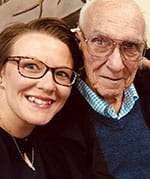After 29 years working in the United States military and a life of almost perfect health, Bud was diagnosed with cirrhosis. He needed a transplant, but at 75 years old, he knew that the surgery would be hard on him.
The Challenge: Metabolic Dysfunction-Associated Steatohepatitis (MASH)
“I was in the military for 29 years. I was physically fit for all those years, running four miles every day, even at the age of 60,” said Bud Mitchell, a former Army recruiter and marine, “And all of the sudden I got this little liver problem.”
Metabolic Dysfunction-Associated Steatohepatitis (MASH), inflammation of the liver which can damage liver cells, leading to cirrhosis. It was also causing Bud’s limbs and stomach to fill with fluid. Every Friday, he underwent paracentesis, a procedure during which a physician drains fluid from the belly using a catheter.
He was draining five liters of fluid every week.
The treatments were time consuming. And they barely kept up with his symptoms. A lot of the time, he still felt tired and uncomfortable. He felt like he was going nowhere, fast.
Bud said, “A friend who had received a transplant told me, ‘Bud, you’re just treading water here. Nothing is happening. Get yourself to Pittsburgh and get this thing figured out.’ I wasn’t getting better, and I didn’t want to do the paracentesis for the rest of my life.”
The Path to Living-Donor Liver Transplant at UPMC
Bud knew he needed a liver transplant. But he was 77 years old at the time, and his doctor was worried.
The liver specialist referred Bud to the transplant center, where he underwent two full days of evaluations to ensure that he would benefit from a transplant and that he could safely undergo the surgery. This evaluation includes:
- Imaging scans
- Blood tests
- Radiology
- Diagnostic tests
- Consults and exams
“Everything inside me got checked,” Bud joked.
Bud had a detailed conversation with his doctor about the risks of transplant and how challenging recovery would be at Bud’s age. His doctor also suggested that Bud look for a living donor.
The Solution: A Parishioner Donates Her liver
At Bud’s age, most of the people he knew were too old to donate, even his son. For a little while it seemed like they might never find a donor.
Bud’s wife was mingling at church, talking about how hard it was to find a donor, when Rachelle Jeffers overheard and offered to donate.
Rachelle said, “I just knew he needed a donor and I just had this voice in the back of my head saying the word ‘offer’.” She told her husband on the car ride home, “I may or may not have offered my liver to Bud, just wanted to let you know.”
Bud was blown away and still sounds amazed when he talks about it. “We were friendly with her parents. We attended her wedding, but never really socialized. She sat in front of us at church every Sunday.”
Rachelle was evaluated and decided to give. On June 1, 2017, Bud Mitchell underwent transplant surgery.
The Result
Over a year later, Bud is back to riding his bike when the weather is nice. The recovery was tough for him, just as he had been warned. He lost a lot of muscle mass and had to work with a physical therapist several times a week to retrain his body for basic tasks.
Getting back to full health was a lot of work.
But now he’s going on bus trips with his wife and taking walks. He’s getting stronger every day and is trying to work up the nerve to hit the ski slopes next winter. He’s so glad that he was transplanted.
“The way I see it—I have already gotten two more Christmases out of it.”
For Rachelle, the recovery was easier. She was young and healthy and went back to work after just a couple of weeks. “There was a learning curve going from being so healthy to being in recovery,” Rachelle said, “I got stuck in the couch a few times, because I didn’t have any abdominal strength. So that happened!”
She gradually built her strength back up and is now training for a marathon.
Bud could not be more grateful. “I thank God for her, she was truly a miracle.”
“Living donation is a powerful thing,” Rachelle said, “It’s an absolutely beautiful experience and sometimes I think I got more out of it than Bud did. Organ donation saves lives.”
Bud and Rachelle’s treatment and results may not be representative of all similar cases.

















